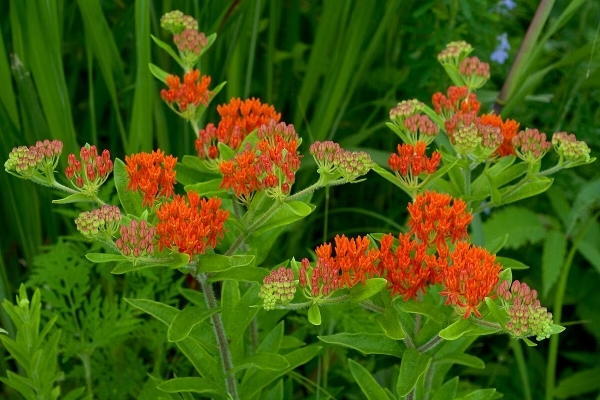
Butterfly Weed
Botanical Name
:
Asclepias tuberosa
Plant Type
:
Herbaceous perennial
Seasons
:
Plant in spring or fall; blooms in summer
Sun Level
:
Full sun; at least 6 hours daily
Ideal Soil Temperature for Planting
:
Consistently above 50°F (10°C)
Soil Type
:
Dry to medium, well-drained soil. Tolerates poor, sandy, or rocky soils
Hardiness Zones
:
3–9 (USDA)
Germination
:
Germination can be slow and erratic, taking anywhere from 2–4 weeks or even longer. Scarification or stratification can improve germination rates
P.H. Level
:
Neutral to slightly acidic (6.0–7.0)
Water/Irrigation
:
Water regularly during the first year. Drought-tolerant once established
Fertilization
:
Generally not necessary
Habit
:
Upright, bushy, clump-forming
Propagation
:
Seed, root cuttings, or division (though division can be difficult)
Final Plant Height
:
2–3 ft
Spread
:
1–2 ft
Flowers
:
Clusters of bright orange (sometimes yellow) flowers
Attracts
:
Butterflies (especially monarchs!), bees, hummingbirds
Uses
:
Butterfly gardens, wildflower gardens, meadows, naturalized areas
Companions
:
Grasses, coneflowers (Echinacea), and other drought-tolerant perennials
Pruning
:
Deadhead spent flowers to prevent self-seeding (unless you want it to spread). Cut back stems in late fall or early spring
Toxicity
:
Considered mildly toxic if ingested in large quantities (contains cardiac glycosides)
Pests
:
Aphids, milkweed bugs, spider mites
Diseases
:
Crown rot, leaf spot
Fun Fact
:
The name tuberosa refers to the tuberous roots
Confused With
:
Other Asclepias species, especially those with orange flowers
Additional Info
:
A crucial host plant for monarch butterflies. The orange flowers provide nectar for many pollinators
Botanical Name
:
Asclepias tuberosa
Plant Type
:
Herbaceous perennial
Seasons
:
Plant in spring or fall; blooms in summer
Sun Level
:
Full sun; at least 6 hours daily
Ideal Soil Temperature for Planting
:
Consistently above 50°F (10°C)
Soil Type
:
Dry to medium, well-drained soil. Tolerates poor, sandy, or rocky soils
Hardiness Zones
:
3–9 (USDA)
Germination
:
Germination can be slow and erratic, taking anywhere from 2–4 weeks or even longer. Scarification or stratification can improve germination rates
P.H. Level
:
Neutral to slightly acidic (6.0–7.0)
Water/Irrigation
:
Water regularly during the first year. Drought-tolerant once established
Fertilization
:
Generally not necessary
Habit
:
Upright, bushy, clump-forming
Propagation
:
Seed, root cuttings, or division (though division can be difficult)
Final Plant Height
:
2–3 ft
Spread
:
1–2 ft
Flowers
:
Clusters of bright orange (sometimes yellow) flowers
Attracts
:
Butterflies (especially monarchs!), bees, hummingbirds
Uses
:
Butterfly gardens, wildflower gardens, meadows, naturalized areas
Companions
:
Grasses, coneflowers (Echinacea), and other drought-tolerant perennials
Pruning
:
Deadhead spent flowers to prevent self-seeding (unless you want it to spread). Cut back stems in late fall or early spring
Toxicity
:
Considered mildly toxic if ingested in large quantities (contains cardiac glycosides)
Pests
:
Aphids, milkweed bugs, spider mites
Diseases
:
Crown rot, leaf spot
Fun Fact
:
The name tuberosa refers to the tuberous roots
Confused With
:
Other Asclepias species, especially those with orange flowers
Additional Info
:
A crucial host plant for monarch butterflies. The orange flowers provide nectar for many pollinators
Written by Nondiah Khalayi – https://www.linkedin.com/in/nondiah-khalayi/

